St Matthews' Manly Dedicates Darley Smith Building
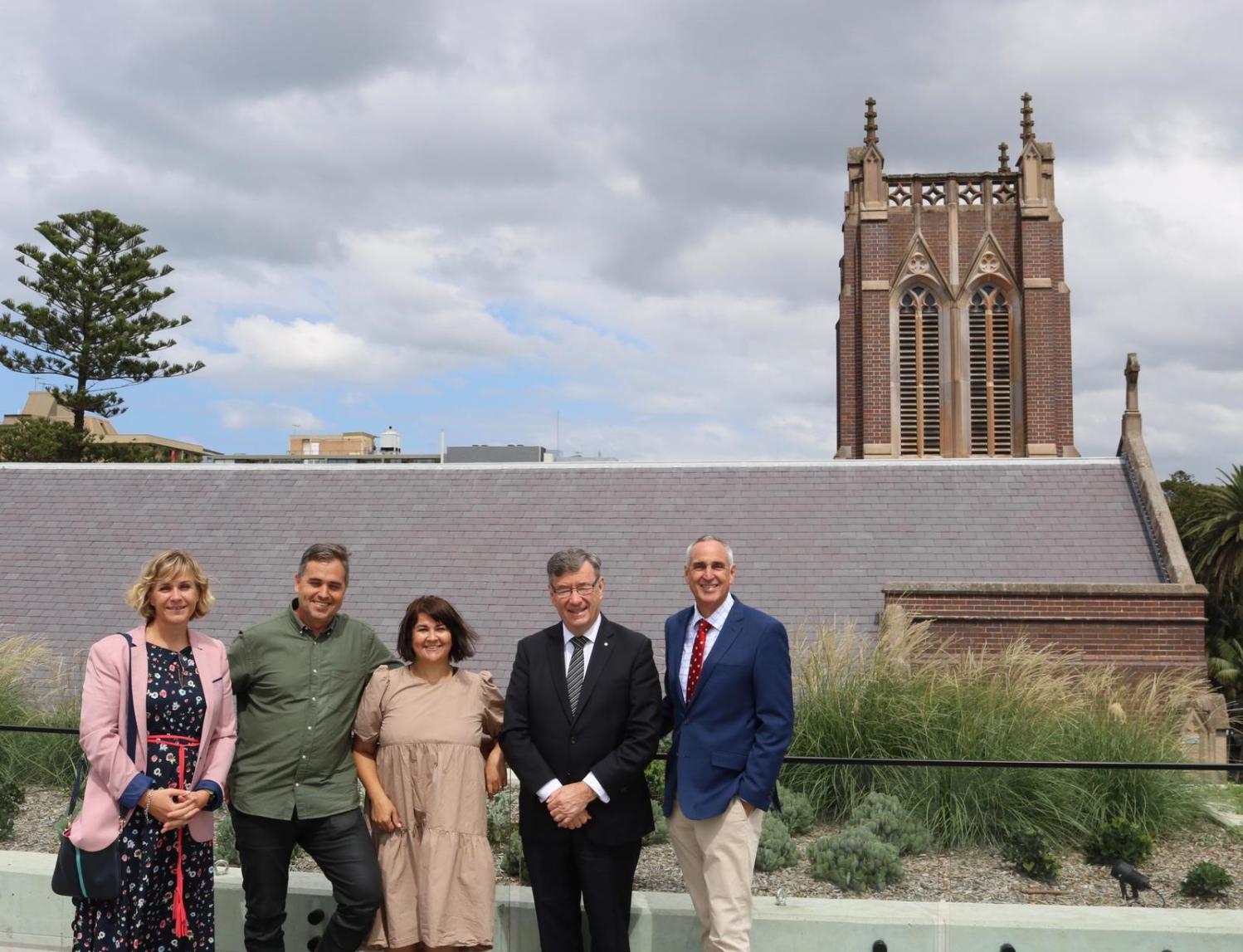
Member for Warringah Zali Steggall MP this week shares some great news in her newsletter regarding attending the opening of the rejuvenated Darley Smith Building in Manly Corso, named to honour key figures in the history of Manly, Henry Gilbert Smith, known commonly as the father of Manly, who made land available for a church in 1857 and Captain Benjamin Darley and his family also set aside land on The Corso for a new church building. Darley married Katharine, daughter of D'Arcy Wentworth and Ann Lawes.
At a ceremony on the Manly Corso on October 4th 2018, the congregation of St Matthew’s, Manly gathered with members of the community to celebrate the first turning of the sod on a new project.
For years, the wardens of St Matt’s had been planning and saving and working hard to ensure that the retail space owned by the church since the 1920s could be upgraded in order to continue serving the community in the future.
“It’s the first six shops on the southern side of the Manly Corso,” the Rev. Bruce Clarke, Senior Minister at St Matt’s, explained then.
“The second floor will be a 200 seat auditorium for ministry and also community use, and a rooftop terrace with a barbecue and a kitchen. We’re hoping to provide a range of things for training, entertaining and fellowship.” Rev. Bruce Clarke stated
“It will give us increased space in terms of doing ministry,” he said. “Our children’s and youth ministry have grown significantly, so it will provide quality space for doing ministry and be a helpful bridge into the community.”
The redevelopment was expected to take 13 months, weather permitting, and be completed by Christmas 2019. The whole project was costed at $12 million.
Well, we all know what happened by Christmas 2019 and what persisted throughout 2020 and even into January 2021.
However, the rejuvenation has recently been completed and Ms Steggall MP attended the opening and Dedication on March 3rd, 2021.
The Dedication was given by the Rev. Glenn N Davies, Archbishop of Sydney.
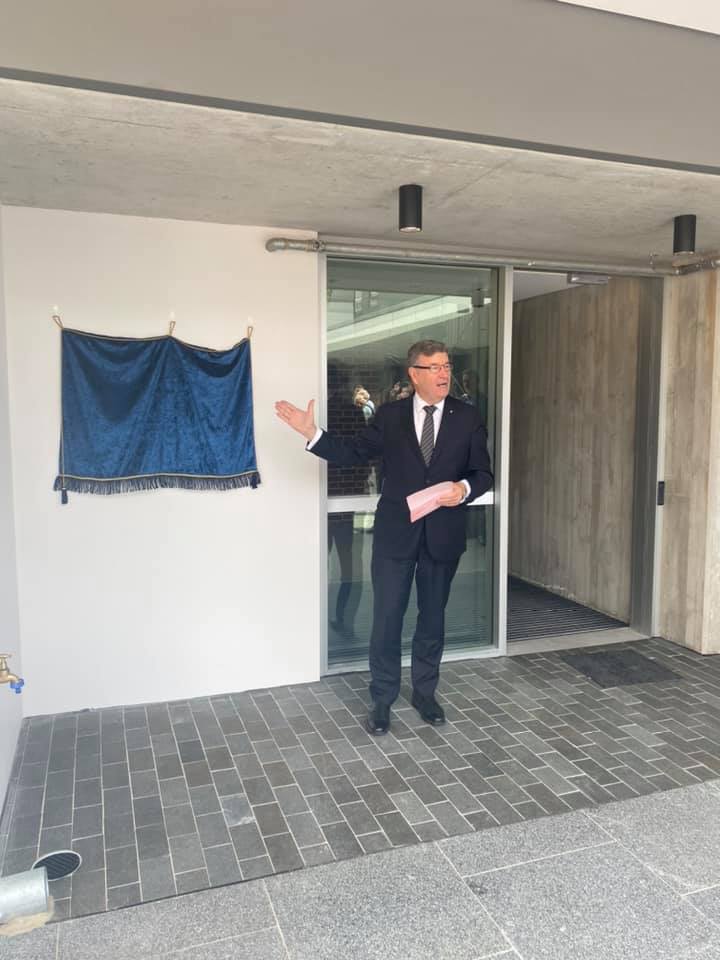
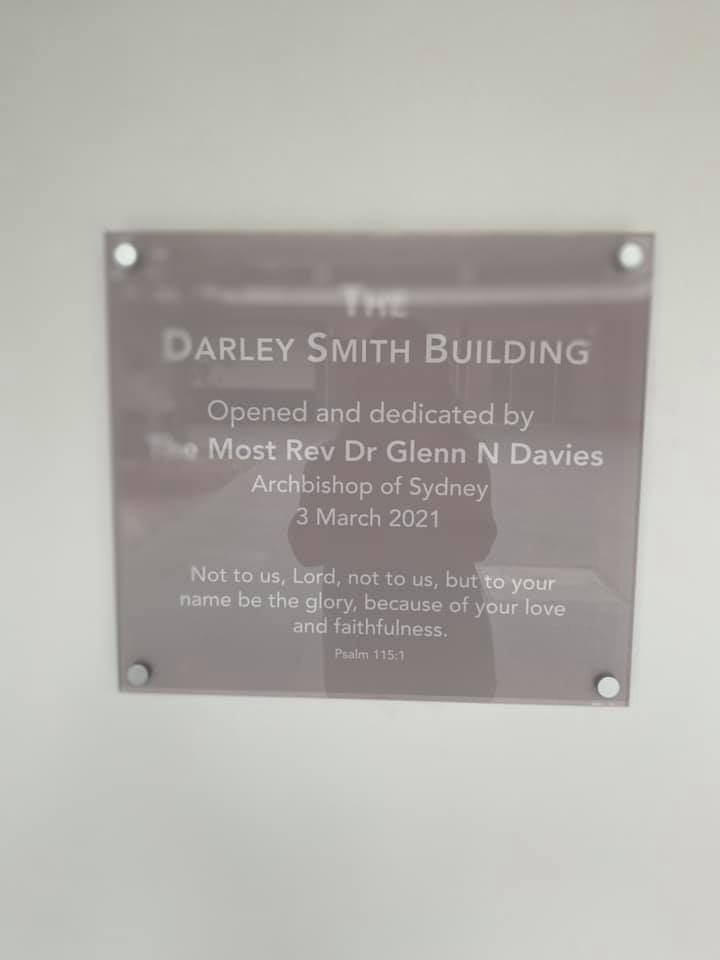
Although the interior is shiny and new, the façade of the heritage-listed building remains the same, connecting Manly's past with her future, and honouring while celebrating Architecture in Sydney.
''Thank you to St Matthew's Church in Manly for having me at the opening of the Darley Smith Building. St Matt's has been integral to the Manly community for many years, including its support for homeless.'' Warringah's MP states in her weekly update
''The Darley Smith building showcases amazing architecture by Du Plessis + Du Plessis Architects who are a local husband and wife duo, Eugene and Henke Du Plessis. I'm sure the Manly community will benefit from the state of the art auditorium for many years to come.''
For more information about the church go to www.stmattsmanly.org.au
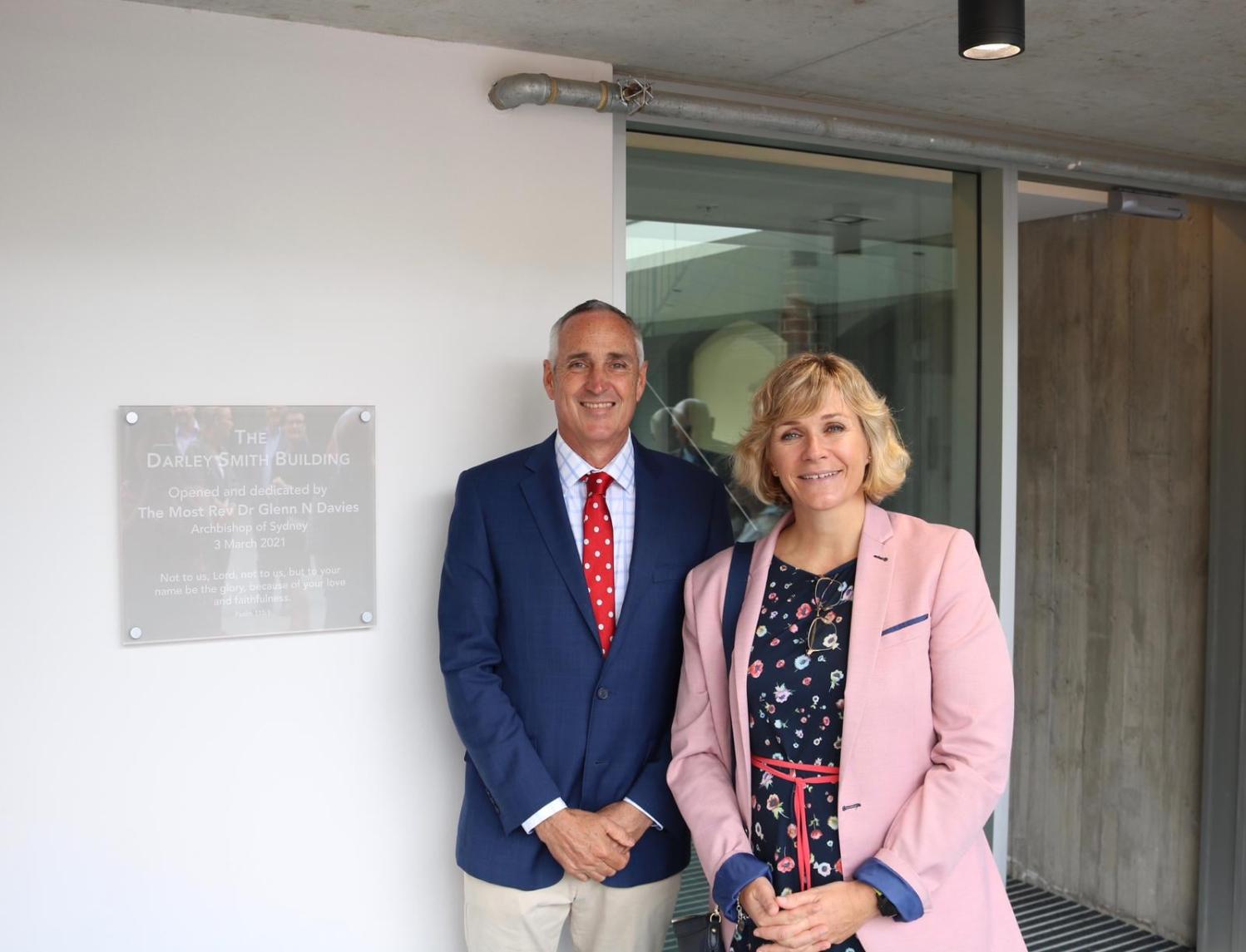
Some Notes from the pages of the past
The first St Matthew's church was a 6m x 15m timber structure built by Manly's founder, Henry Gilbert Smith, at the corner of The Corso and Darley Road on land owned by Katherine and Benjamin Darley. The timber church, also used as a schoolroom, was under construction in 1857 and was completed the following year, but was not officially opened until January 2nd 1859:
CHURCH OF ENGLAND, Brighton, Manly Beach.
Members of the Church of England, and others interested In the progress of religion, are respectfully informed that the Church erected at the above place will be opened on SUNDAY next, January 2nd, when Divine Service will be held and a Sermon preached, at half-past four in the afternoon, by the Rev. P. P. AGNEW.
.jpg?timestamp=1615581269625)
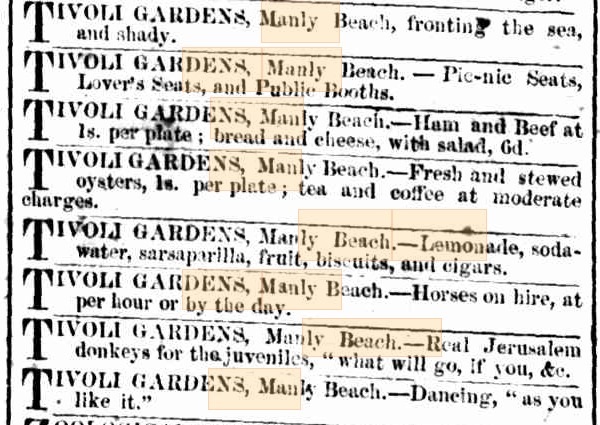
Advertising (1859, January 1). The Sydney Morning Herald (NSW : 1842 - 1954), p. 1. Retrieved from http://nla.gov.au/nla.news-article13014676
Sermons were delivered by Rev. Peter Agnew, who worked across NSW.
In 1864, the Darleys conveyed to the Bishop of Sydney 'God's Acre' - one acre of land fronting The Corso for 10 shillings, a gifting, which was enhance by a donation of 50 pounds. The Darleys were specific in their gifting; the land was for the erection of a Church of England, along with a parsonage and schoolroom. Henry Gilbert Smith, also a generous contributor to the new church, employed renowned architect Edmund Blacket to design it. Mr. Blacket also designed St. John's at Camden.
Blacket produced a finished design in the form of a cross, but only the nave was initially built, leaving the chancel and transept to be built at a later date. Able to house 170 people, the 15m x 7m nave cost 1300 pounds to build and once completed, its 75 feet (23m) high bell tower rose above The Corso. The old timber church next door was converted and later rebuilt to house a Sunday school and a grammar school.
The new church was dedicated on Wednesday April 5th, 1865 - the ceremony and Service conducted by Frederic Barker (17 March 1808 – 6 April 1882), the second Anglican bishop of Sydney.:
CONSECRATION OF ST. MATTHEW'S CHURCH, MANLY BEACH.
THE new Episcopalian church at Manly Beach, to be called St. Matthew's Church, and also the burial ground belonging to the church, were, yesterday, consecrated by the Bishop of Sydney. The new church, which is a conspicuous object in the Corso, leading from the hay to the beaoh, is a neat and attractive structure, in the carly English siyle. At present only the nave has been erected, it brina; intended to add the chancel and the transept at some future time; the nave is forty-eight feet by twentyfour, and will seat nearly two hundred persons. At the western end of the church there is a neat bell turret, with a spire terminating at a height of seventy-five feet from the ground.
The two western windows are of stained glass, designed and executed by Mr. John Falconer ; they are geometrical in shape ; the beauty of the design and also of the workmanship, are very creditable to Mr. Falconer, who was, we learn, the first to start glass staining in the colony.
One of the windows is in memory of the late Captain Darley, and was given by Mrs, Darley and her children; the other is in memory of the late Lieutenant .William Henry Bayley, and was given by Mrs. Gurney and her relatives. The pulpit and reading desk are the present of Mr. Rolfe ; the coverings for the communion table and for the reading desk were given by Mrs. Thomas Cooper ; the font is the gift of Mr. Brown of the Steyne Hotel; and the benches were provided by public subscription. The cost at present incurred has been about £1300;.of this £455 remains to be subscribed.
The architect for the church was Mr. E. T. Blacket; the masonry was carried out by Messrs. Euton and Co., and the roof was constructed by Mr. A. Dean.
The Bishop of Sydney, who was accompanied by the Rev. W. B. Clarke, the Rev. T. Kemmis, the Rev. T. Smith, the Rev. W. Lumsdaine, the Rev. W. Stack, the Rev. W. Allworth, the Rev. C. Ord, and the Rev. W. F. Creeny, arrived at Manly soon after eleven o'clock,' by the steamer Breadalbane, which also conveyed a number of visitors from Sydney. The church was well filled some time before the Service commenced.
The Bishop having taken his seat at the Communion table, the petition for consecration, from the ministers and parishioners, was presented to him and read by his directions ; after which the sentence of consecration was read.
The Bishop with the clergy then walked down the principal aisle of the church and back again, the Bishop beginning the 24th Psalm-" The Earth ls the Lord's and all that therein is"-and the clergy repeating the alternate verses. The prayers according to the Form of Consecrating Churches (books of which were distributed through the church) were then read by the Bishop; after which, the Service of the day was read by the Rev. G. Gurney, the minister of the church ; the First Lesson being read by the Rev. W. B. Clarke. In the Communion Service, thc Bishop was assisted by the Rev. W. Stack.
The Psalms of the day were chaunted, and the choral portions of the service were sung with proper effect, by the choir of the church ; Mr. Leen officiating at the harmonium.
The sermon was preached by the Bisnor of SYDNEY, who took for his text 2 Corinthians chap. iv. ver. 5, " For we preach not ourselves, but Christ Jesus the Lord ; and ourselves your servants for Jesus' sake."
The Bishop commenced by remarking that if his hearers had seen the apostle Paul working with his own hands as a tent-manufacturer, and had been told that he had entered Corinth with a determination to overcome its idols and to convert men who were the servants of Satan into the servants of the Lord Jesus, they would naturally have asked, by what power did this person, whose bodily presence was weak, and his speech contemptiolc, propose to work such mighty changes. But those who looked at the success that attended the apostle's labours must acknowledge that that power which wrought so great a change must be Divine ; that he who had been the instrument of bringing men out of Satanic darkness into Heavenly light, must have been an instrument in the hands of Almighty God. But it might be asked-how did he effect these changes. He was a learned man, of a philosophical class of mind, and brought up in one of the most famous schools, yet in nothing of this nature did he trust ; he trusted to no philosophy or eloquence, or earthly wisdom ; but he determined to know; nothing amongst men but Christ and him crucified."
He could have stirred their hearts to their very depths by that eloquence of which he was the master ; he who could preach, as at Mars Hill, to an Athenian audience, could have had recourse to much philosophy and worldly wisdom : but this was the secret of his success-he preached not himself but Christ Jesus the Lord. And the same agency was still at work; the Gospel was older than the hills, it was the everlasting Gospel. The same message was committed to us; the same power was committed to us; the necessity existed still, and, thank God, the success was the same. Let any one now preach with the self-denial, the spirituality, and the devotedness of heart and life which characterised the Apostle Paul, and he should have the same success.
We follow up the steps of that great Apostle, and we believe that the work of God is still manifest in its saving and sanctifying power wherever it is Scripturally preached and prayerfully applied. This day, a new house of prayer is opened ; the wilderness and the solitary place have been made glad with the sounds of rejoicing, and from henceforth for ever, he trusted there would go forth from this sanctuary a stream of blessing. But, as every blessing might be turned by man's sin into a curse, so, as his text declared, the preaching of Christ's Gospel itself was capable of abuse. It was abused by those preachers who made self-glorification the end and motive of their actions, by those who preached the traditions of men, by those who were actuated by love of reputation and honour amongst men, and also by those who preached rather to their congrega-tions than for Christ. In opposition to all of these the Apostle said " We preach not ourselves but Christ Jesus the Lord."
This was a kind of creed, a declaration of the Apostle's faith, and contained, in fact, the substance of the Christian religion. The Apostle also reverted to his own position, " Your servant for Jesus' sake." And so were Christian ministers now the servants of the Church, for Jesus' sake.''
The Bishop proceeded to urge those who were engaged in the work of the ministry "not to preach themselves but Christ Jesus the Lord," and appealed to the members of that congregation to receive the preaching of the Word as the ordinance of God, and as a message from God.
In conclusion, be hoped that the desires with which this house of prayer had been erected might be accomplished, and that those who had engaged in this work of faith and Iabor of love might realise the blessing of God on their handiwork.
At the close of the service the Sacrament of the Lord's Supper was administered.
The Bishop, the clergy, the choir, and some of the congregation then proceeded to the burial ground, which is situated about a mile and a half from the church on the Balgowlah Road. The ceremony of consecration was performed by the Bishop, who read the prayers directed to be used on such occasions. The choir then sung a portion of the metrical version of the 39th Psalm, after which the Bishop pronounced the benediction.
Upon returning from the burial ground, the Bishop, the clergy and some of the visitors from Sydney were entertained at a substantial luncheon in the Church of England schoolroom. On the termination of the repast the Bishop, who presided, proposed the health of Mr. Gilbert Smith, who had been a large contributor to the erection of the church.
Mr. SMITH having responded, the Rev. W. B. Clarke, proposed the health of the incumbent, and the Rev. G. Gurney. The Rev. returned thanks. The Bishop next gave the health of " The Visitors," on behalf of whom the Rev. T. SMITH responded. The concluding toast was the health of the Bishop of Sydney and Mrs. Barker, which was suitably acknowledged; The company then retired, and returned to Sydney by the after-noon steamer. CONSECRATION OF ST. MATTHEW'S CHURCH, MANLY BEACH. (1865, April 6). The Sydney Morning Herald (NSW : 1842 - 1954), p. 5. Retrieved from http://nla.gov.au/nla.news-article30936462
During 1876 the construction of the transept and chancel according to Blacket's design once more became an item for discussions with a decision to proceed. The foundation stone was laid in 1881 and the completed church was opened in 1882. Around this landmark things were changing though. In late 1879, the roads on what was then called the Basset-Darley Estate, covering all the land on the flat of Manly southeast of The Corso, were dedicated for public use, as was a 10m strip along the southeast of The Corso menaing this was widened from 18m to 28m, and that left the church jutting 6m into it.
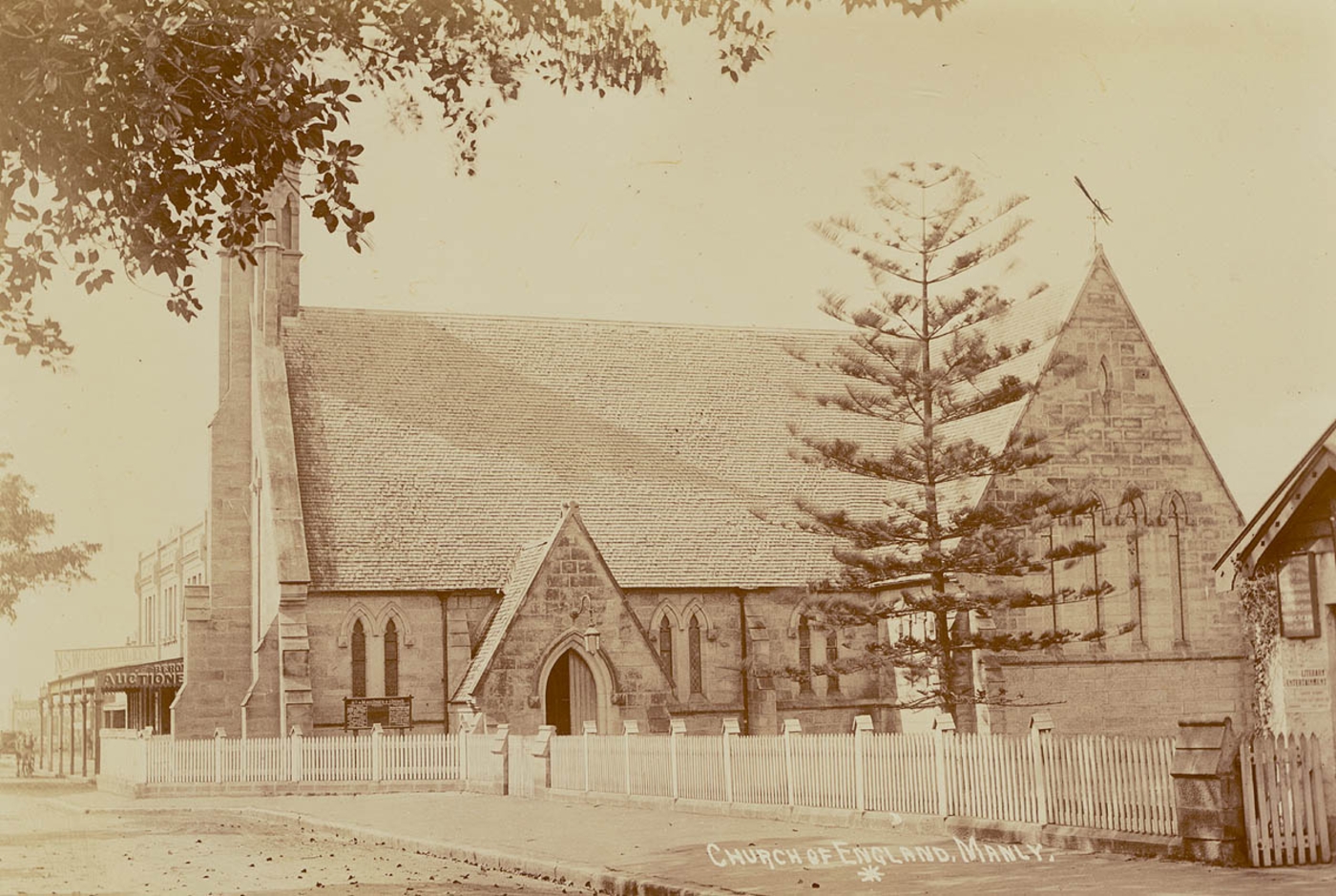
St. Matthews Church of England, Manly, circa 1900-1910, by Star photography, Item a116253h, courtesy the State Library of New South Wales.
The 1859 timber structure on the corner of Darley Rd and The Corso was demolished and the Victoria Hall was built on the site in 1901 for the Sunday school and parochial meetings. Shops along the street front were later added to provide the church with an income.
By the mid-1920s, St Matthew's was under pressure to bring the church in line with the rest of The Corso structures, Manly Council wanted the church moved back to the same building alignment as the other structures on The Corso and Victoria Hall was considered a fire risk. The last service in the old church was held on July 1st, 1928, after which it was quickly demolished to make way for the parish hall and shops, which were completed in 1929. Victoria Hall was then demolished to make way for the new church, the foundation stone of which was laid on April 20th, 1929. Most of the significant pieces of furniture and some of the stained-glass windows from the old church were transferred to the new one, which was opened on September 20, 1930.
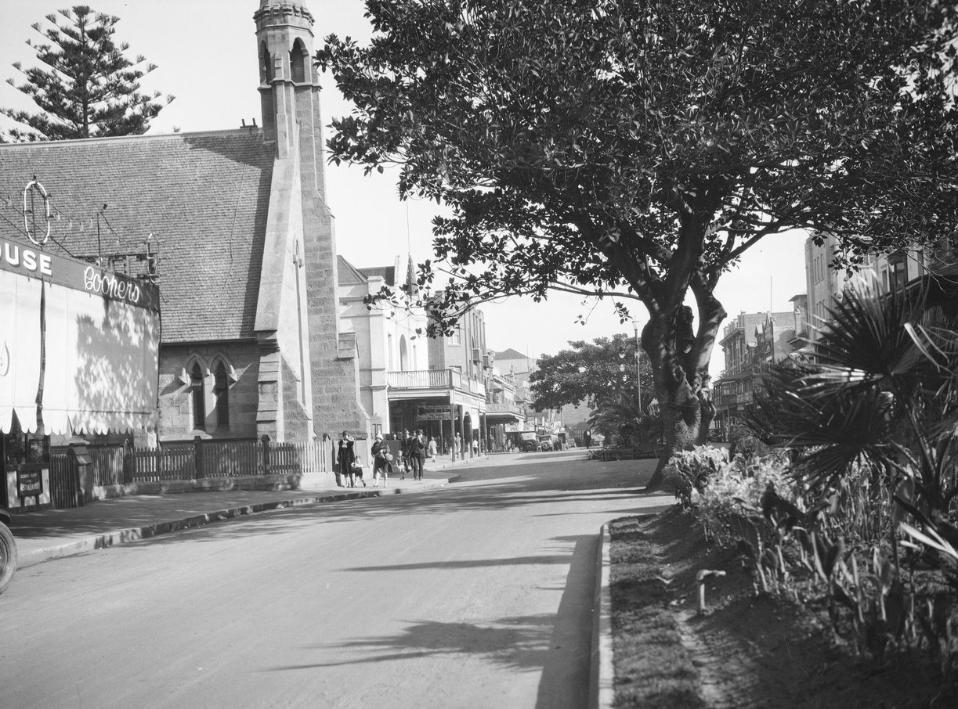
Manly Corso and St Matthews Church, June 1928. Photo by E.G.Shaw. courtesy State Library of NSW.
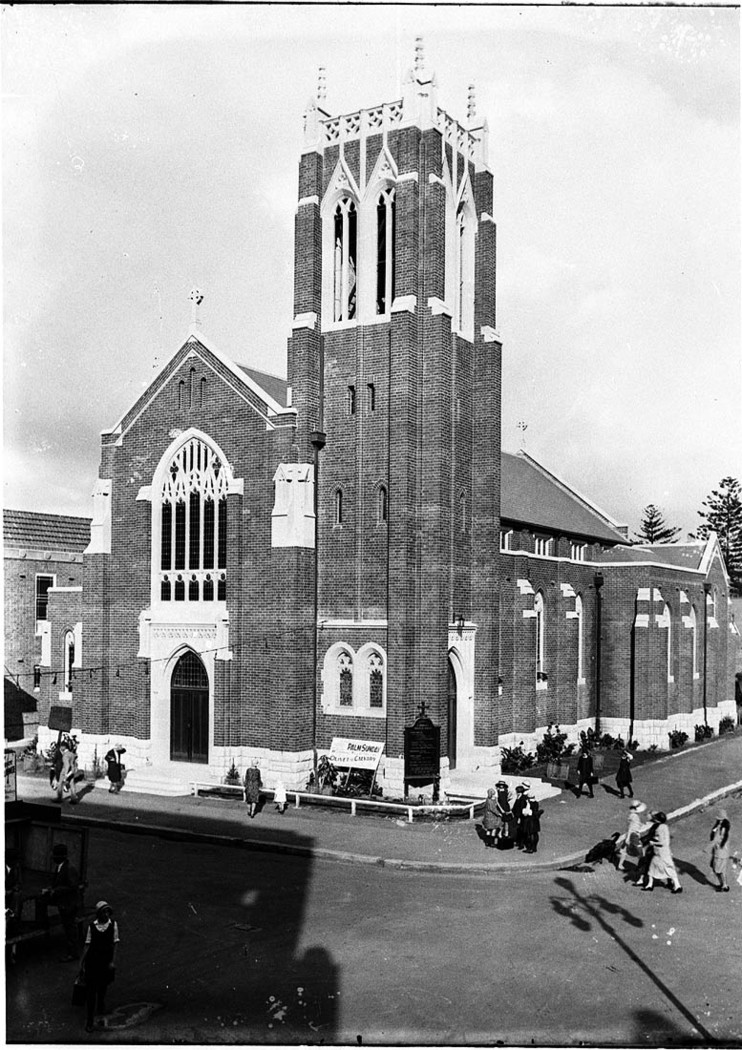
Manly, St Matthew's Church, Item hall_34768h, courtesy the State Library of New South Wales.
The gentleman who oversaw the changes was Rev. Arthur Ebbs, rector of St Matthew's from 1924 to 1948.
During the Depression, Rev. Ebbs founded St Matthew's Training Farm for youths at Dee Why West, now called Cromer, and between 1932 and 1940, about 900 young men passed through the farm, most of them later obtaining employment. During World War II Rev Ebbs provided hospitality for servicemen in St Matthew's Parish Hall and between December 1929 and September 1945, around 48,000 men were given beds when they needed them.
Rev Ebbs was appointed a Member of the British Empire (MBE) in the New Zealand honours list in 1946 because many of the servicemen were New Zealanders.
At the time of the appointment, it was reported that: "Mr Ebbs and the hostel's voluntary workers are proud of the fact that no man was charged a penny and that every man was given clean linen on his bed, supplied with a two shilling ticket for breakfast at a Manly café and looked after in every way possible."
A few more notes from the pages of the past on Manly churches and shop fronts:
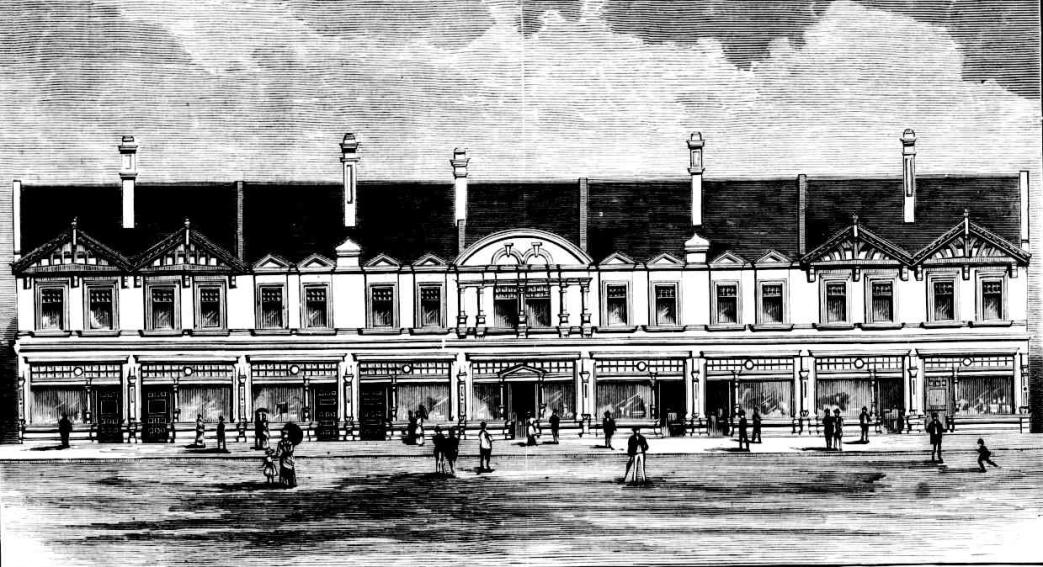
MANLY PRESBYTERIAN CHURCH.
The pretty marine suburb, Manly, is to receive a very welcome addition to its church architecture in the form of a very handsome stone church for the accommodation of the Presbyterian community. Perhaps no site commanding a more charming prospect could have been chosen than the one where the edifice is to be erected.
Overlooking the park, the view takes in the entrance to the port, and then look out to sea over the ocean beach. The building, which is to be erected in two sections consists of a nave 34ft. 6in. in width by 74ft. in length, transepts each 14ft, deep by 23 ft. wide, and pulpit and organ recess measuring 17ft. deep by 25ft. wide. These, together with the necessary vestries and sessions-room, will be added when the increased congregation renders an enlargement desirable. The present accommodation will allow for 266 adults, and the total will be for 594 adults. The pulpit platform is to be central, and everyone will be in view and hearing of the preacher, as there arc no intercepting columns and the length of the building is moderate. Further, the floor of the nave is to be laid to a slight slope, thus affording a better view of the pulpit.
Externally the principal feature will be a square tower covered with a pointed roof rising to a height of 93ft. from the ground, and a handsome porch attached thereto forms the principal entrance. The second entrance is obtained at the western side of the front, both accessible from the main . street in front of the site. These porches arc so arranged as to check draughts in the winter. The main gable is occupied by three large and handsome windows, to be filled with stained glass, and the flank walls have pierced by smaller windows, with special ventilating openings ornamentally treated above the same. The transepts are also marked by bold two-light windows and the vestries and sessions-room are lighted by windows especially designed to suit their respective purposes.
The site being on the rugged flank of a hill and the church being visible from a considerable distance the architect (Mr, John Sulman, F.R.I.B.A.) has designed the building in the Romanesque style, as best harmonising with the surroundings. The out-line will be bold and vigorous but the detail refined. The walls are being constructed entirely of white stone given by Mr. Broad and the roofs will be slated. Internally the roof principals will be treated very ornamentally and form an attractive feature. The details of lighting, ventilation and acoustics have been carefully studied, and in each respect it is anticipated that a perfect success will be obtained. The seating of the church will be a gift from Mr. J. Wood, of Fairlight. The contractor is Mr. D. M'Rae.
The ceremony of laying the foundation-stone was performed on Saturday afternoon under must favorable auspices by Mrs. J. H. Goodlet. There was a large assemblage of ladies and gentlemen, among those present being Mrs. Steel and Gilchrist, Revs. A. Miller, It. M'Kinnon, J. Walker, C. Moon and Kamblin (Western Australia), Messrs. T. Littlejohn, C. ft. Have, J. Broad, ,J. Patterson, G. Littlejohn, W. J. Lj-uo, jr. P., W. J. Vivian, J. Cameron (Mayor of Manly), Miller, J. A, Dean, M'Pherson, J. Sutherland, Candlish, and Alderman Dean.
The proceedings began by the pastor, the Rev. T. J. Molyneux, MA., L.L.B., delivering an address, in the course of which he briefly sketched out the origin of the church at Manly some four and half years ago, when he was sent to the district by the church extension committee.
After a year's pastorate a site was promised by the late Mr. Smith. The church that was now to be built was estimated to cost £0700, and towards that £1100 was in hand while there were two promises of' further subscriptions upon certain conditions.
Dr. Steel then offered up the dedicatory prayer, after which Mrs. Goodlet laid the Stone, in the cavity of which was deposited a tin case obtaining copies of the annual reports of the church for the past three years and the metropolitan and local papers of the day. Instead of the usual silver presentation mallet and trowel, an illuminated address, bound in morocco and very tastefully got up by Mr. John Sands, was presented to Mrs. Goodlet by Mr. T. Littlejohn on behalf of the congregation. T... Mrs, J. H. Goodlet by the congregation and members of the Manly Presbyterian Church on the occasion of her laying the foundation of the building on Saturday, April 15, 1889.1! Brief addressees were then delivered by Mr. Littlejohn, thanking Mrs. Goodlet for her attendance, and by Dr. Gilchrist. The offerings on the stone amounted to the handsome sum of £485. The ceremony concluded with the pronouncing of the benediction by the Rev. It. M'Kinnon, after which the company adjourned to tho rear of the pavilion in Manly Park, where afternoon tea and other light refreshments were served. MANLY PRESBYTERIAN CHURCH. (1889, April 15). The Daily Telegraph (Sydney, NSW : 1883 - 1930), p. 6. Retrieved from http://nla.gov.au/nla.news-article235868922
Manly and Its Churches.
(BY PEREGRINE.)
(See illustrations on this page.)
Manly is always lively, always a pleasant place to go to. When I last visited it, it was for the purpose of having a look at its churches and giving some idea of the work of a religious kind which goes on in the place.
I don't know why grotesque ideas should come into one's head at odd times, but as the Fairlight drew near the pier the old conundrum about Robinson Crusoe came into my head : " Who were the first persons he saw when he landed at Juan Fernandez ? A great swell on the shore, and a little cove running in." At Manly I could see 'many great swells on the shore, and lots of little coves ; but they weren't running in, they were perched upon the end of the pier, earnestly pursuing the craft of those who Beguile the finny tribe, and draw to land.
I watched the youngsters for a bit, and quite envied the joy which shone upon the juvenile face as a wretched little whiting, no bigger than a sprat, rewarded the tiny fisherman's toil.
Perhaps the prettiest street in Sydney or its suburbs is the "Corso" at Manly, with its grand row of trees running down the middle, its bright shops on one side, and its pretty church and modest grammar school on the other, it has a kind of " boulevard " look which is pleasant. By ' the way, talking of " boulevards," I wonder how many people know that it is really the same word as " bulwark," and means the same thing. From the fact that the fortifications on the walls of ancient cities were broad and elevated, and so became a favorite promenade, the word began to be applied to great and wide streets, and hence its modern meaning.
The Church of St. Matthew's is a pretty and substantial stone edifice in the Gothic style. As yet only nave and transepts are built, but some day, it is hoped that a chancel may be added, which will relieve the congestion at the eastern end of the church. I am afraid that in my illustration I have injured the feelings of the corporation, for I have knocked down a lamp post or two and a couple of fenced-in trees. I had to do it, for otherwise I could not show the church, and grammar school as I should wish.
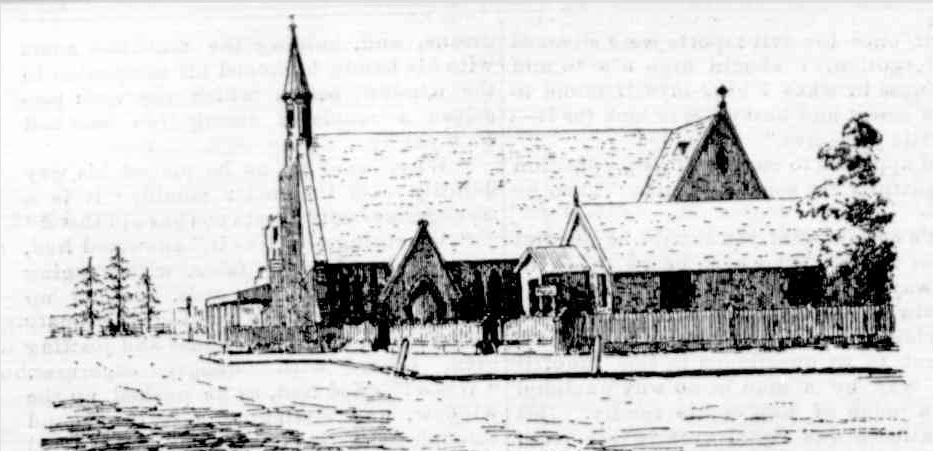
1.- St. Matthew's Church and Grammar School, Manly.
The incumbent of the parish is the Rev. E. S. Willis, and his district extends far beyond the precincts of the charming town of Manly. There is a large out-parish attached to the cure, which includes the beautiful district of Pittwater, and also Middle Harbor, Newport, Greendale, and a few other minor places. All these have to be served from the central church, so that the aid of a curate is necessary, in order that the duty may be effectively and regularly done. The incumbent is a hard worker, a good man of a good school, is beloved by his people, and goes on his way doing good work in a quiet, earnest way, an excellent type of an Anglican parish priest. There are the usual Sunday services, a weekly celebration of Holy Communion, and also Holy Communion and other services on holy days in great festival.
The services at this church are on Sundays or great festivals, fully choral ; there is a surpliced choir of about 30, and the service of the church is well and reverently sung. There is not a parish in Sydney or in the suburbs where the service is better than that of the cathedral, hardly one where it is so good. This is owing to the .distinguished ability of the organist, Mr. Alfred Pooley, and the unremitting labor which he and his musical wife ex-pend in the instruction of the members of the choir. I do not know a church in the neighborhood of Sydney into which it is such a pleasure to go, and I can only say that if the many week-day toilers, who make Manly their Sunday resort, were to avail themselves of the services of S. Matthew's, they would not only be charmed by the rendering of the good old liturgy of the church, but have their day of rest made more restful by the enjoyment of hallowed and melodious worship.
The plain though substantial building: which stands at the corner of the street is the Church of England Grammar School. It is under the charge of an able and efficient master, Mr. A. A. Gailey, a graduate of the University of Dublin, and I am told that since his appointment to it both attendance and efficiency have increased. The schoolhouse is used as a Sunday school, and there is also a service for the children every Sun-day at 11 o'clock. Here, in beautiful Manly, .religion and education go hand in hand, to the great advantage of the boys of the place.
The Congregational place of worship is in rather an awkward position for a sketch. If one tries to get at it from the side leading from the park, a great wall cuts out the half of it, if from the opposite side it is half hidden by the pastor's house, so there is nothing for it but to take it from the front, so sitting on the door step I get it in, quite conscious that the acute perspective takes from its claim to be picturesque. It is a goo'd structure of that type of Gothic known as Early English, the simplest, and in many ways the most useful of all the Gothic styles. I was given to understand that the church and its agencies were well worked by the present pastor, the Rev, P. Warner, whose name is a guarantee for energy and ability.
.jpg?timestamp=1558906553655)
2.-Congregational Church, Manly.
There are good Sunday schools, and many valuable agencies for good, with frequent services on Sundays and week days, and a go-ahead spirit of earnestness about everything connected with " Independency " in Manly.
The Wesleyans have a neat, wooden place of worship, and the Roman Catholics are building a magnificent church. The walls are up, and it is being roofed in ; but I did not sketch it, preferring to wait until some future day, when I should see it in all the beauty of completion.
But by far the most beautiful ecclesiastical structure in Manly is the Presbyterian "Kirk." I wish I could have done it more justice, but the fact is that its commanding position on the hill at the back of the town renders it necessary to sketch it from some little distance. Seen from the road which cuts the park at right angles, it makes a very pretty picture indeed, with its background of gum forest and rock. These serve to throw out its noble proportions and graceful architecture into bold relief. As my .readers will see for them-selves, it is built in the best Italian style-that charming combination of Romanesque and Nor-man which, with Renaissance modifications, makes' buildings of this type appear so graceful, strong, and captivating.
.jpg?timestamp=1558906522861)
3- Presbyterian Church, Manly.
The minister is the Rev. Dr.Molyneox, who has a high reputation as an eloquent preacher, a faithful pastor. Not far from the church is the new manse, a very fine house, indeed, which owes its existence in its present condition to the generosity of the Presbyterian squire, Mr. J. M'Gaw, of Daily's Castle, who has given most of the money for its erection.
I understand the services are good and well attended, and that the choir is efficient and well trained. - There is a magnificent three manual organ, by Hill and Son, on its way out from Eng-land, which is also a fruit of the liberality of Mr. M'Gaw ; when, what the old Presbyterians used to call " the kist o' "whustles " comes, no doubt ! the services will be still more harmoniously tendered.
After all labor there is rest, so, my sketching ended, I am glad to take shelter from the Bun under one of the trees on the Ocean Beach, and to enjoy the freshness of the sea and the beauty of the loveliest coast line about Sydney. Chat-ting to a friend, who is an invalid for the time being, and has to be wheeled to the beach in a chair, he tells me an amusing story of misdirected religious energy as regards himself. One day as he Bat in his chair on the beach, a very mature and solemn-looking female came up to him, and after a few patronising, district visitor kind of remarks, put a tract into his hand, and went away to try her hand on some one else. When my friend opened the precious "menage of peace," he found several pages of very poor doggerel, which the good woman had selected as forcibly applicable to his case. The opening lines were :
Alas! alas! and here I Bit, A worn-out. useless thing, which, considering my In end isn't 80 yet, was just a bit too rough. If the zealous tract distributor had only known that " my poor man" had a " handle to his name as the brother of a peer of the realm, I think she would have had a fit. My friend actually had a fit on the strength of it, but it was a fit of the most uproarious laughter, which not even the righ-teous indignation of his charming wife could restrain.
It was pleasant to sit there as the afternoon grew into evening, the soft thunder of the bil-lows on the beach making music in our ears, and the fresh sea breeze pouring ozone into our lungs. Pleasant! too to talk of the ancient town by the Cam, which we both knew well and loved. Pleasant to recall funny stories of the red-bearded Hussar of Downing, and of the eccentricities of "Joey P." But inexorable time calls us away from the contemplation of the loveliest beach in Australia, and from happy memories of the classic fen-land town, and the "Brighton" takes me back through golden scenes of sunset beauty to the city, with the sense of peace and rest which always follow another pleasant day at Manly. Manly and Its Churches. (1892, April 9). Australian Town and Country Journal (Sydney, NSW : 1870 - 1907), p. 30. Retrieved from http://nla.gov.au/nla.news-article71236306
Show of Wild Flowers at Manly.
It is only when an exhibition such as that at Manly, on Friday, Saturday, and Tuesday, brings vividly before us the bounty of our native soil, its harvest of beauty, that we learn how really great is the floral wealth of our own home. About this time of the year there often pass through the dusty streets parties of young people who have brought from far up the harbour, bunches of wild roses, or lengths of wild sarsaparilla knotted with clustered purple blossoms; and these and a few other of the commoner bush flowers constitute the great mass of the people the flora of the colony. They have really no idea of the wonderful variety of flowers scattered over the fields and hills around them. Those who despise Australian wild flowers, and whose notions of our indigenous vegetation is confined almost to the limits of a knowledge of the ' eternal gum tree,' should have seen the show.
It is two years since the last show of native flowers was held there, and for days past the hills at the back, and the rocky heights along the shore, have been searched by eager parties of amateur botanists and florists. Happy was the one who found a great piece of native clematis now just breaking into blossom, or a fine bunch of lilies, or rarer than all a plant of the pun white native rose. Then the damp dark gullies were explored, and lovely ferns were found hidden away in the moss that 'lies amongst the sleeping stones.' Great indeed was the work of the flower finders, and wonderful was their success. The pavilion in Ivanhoe Park was a very 'bower of beauty.' Nothing prettier has been seen this season. It was opened at noon on Friday, and was, up till 6 o'clock in the evening, when it closed, visited by nearly 2000 people. The early afternoon steamers to Manly from Sydney were crowded— with ladies especially, and also very many gentlemen. Ivanhoe Park was made gay with lines of flags looped from staff to staff, and the pavilion newly painted, and, with the entrance framed in green leaves, looked also as pretty as need be. In the vestibule was a general stall, contributed to by all the stall keepers at the show ; and here encircled by a band of bouquets, and sheltered by a canopy of leaves and ferns, the ladies sold their dainty wares. The stall was presided over by Mesdames Willis and Thornton and a cloud of attendant Misses. It was beautifully decorated ; here, rich scarlet waratahs being set against a background of dark hued leaves, and there being laid out bouquets of forest flowers of every tint and form. Entering the hall the visitor was almost bewildered where to first gratify his sight.
All round were stalls laden with flowers wrought into fanciful devices, or gathered into one concentrated bouquet of a multitude of lesser ones. From each corner of the hall a leafy cable was linked to a central point, from which depended a basket of ferns and creeping plants. At either end of the room sprang an arch and foliage, and ?n ?utS middle space from arch to arch were gathered fem trees, palms, and staghorns. To the left the first stall was that of Mesdames C. H. Hayes and W. M. Jackson. Here all the flowers, in bouquets and other forms in which they were grouped, were noncompetitive, though to these ladies fell the honour of the prize for the best arranged stall. One of the principal exhibits in the stall was a miniature carpet bed, laid out with flowers on moss ; native roses, honeysuckle, blue 'oats' eyes,' and a variety of other blossoms, being formed into stars and other shapes, and surrounded with moss. At short spaces mirrors were set on the carpet, and the toy swans upon them appeared as though swimming on miniature lakes. The ladies' in this stall had put together some really charming bouquets. The great fault, if one can be found in so excellent a show, would be, we should say, the rather crude and inartistic manner in which some of the bouquets were composed. They were too prim and set. Flowers to look their best must be arranged most naturally, and a series of concentric rings or bands of flowers of similar colours, or spaces of white picked out at regular intervals with patches of red or blue flowers, do not represent the acme of beauty. In avoiding this fault, so general among amateur florists, the ladies of this stall were most successful, and some of the bridal bouquets, with beautiful crisp little mow flowers, relieved by lemon-coloured sprigs of rock lily, and the whole seen through a lace work of delicate green maidenhair fern, were perfect little works of art.
An Exquisite heart Service was one of the best of the exhibits, and seat to this emblem of charity were kindred services of the emblems of faith and hope. The next stall— at the head of the hall was that of Mrs. Morris and Miss Miller. There were two very prominent exhibits at this stall, one a dado, from three to four feet in height, formed of squares of different coloured flowers, such as waratah, native rose, daphne, and paeans, in all about eight varieties : and the w... at bank of flowers containing about 8 different varieties, and whose apex was downed by a magnificent Prince of Wales feather formed of rock lilies. Some splendid waratah and lilipilli were also shown in this stall. Mrs. W. R. Rowe and Mrs. Warburton had the next stall on the opposite side of the li'l. Here a most perfect Japanese garden is laid out. It was a charmingly pretty presentation of a lake scene in miniature. A square of mirror was the lake, and the basket were built of very fine velvety moss, fine ferns and little buds serving for the shrubs and flowers and clumps of trees, and miniature fonts being made with larger ferns and plants. A Iittle house perched on a distant hill overlooks the lake on which boats were placed JitlWlsset as if filled with a light wind.
Q-rsice bouquets and baskets of flowers were shown, and also the novel device of two crowed tennis bats worked in flowers. The stall next in order to this 5' tat of Mm. Medcalfe and Miss Underwood. There were several novelties, such as a parasol of flowers and a Union Jack worked in native roses, white
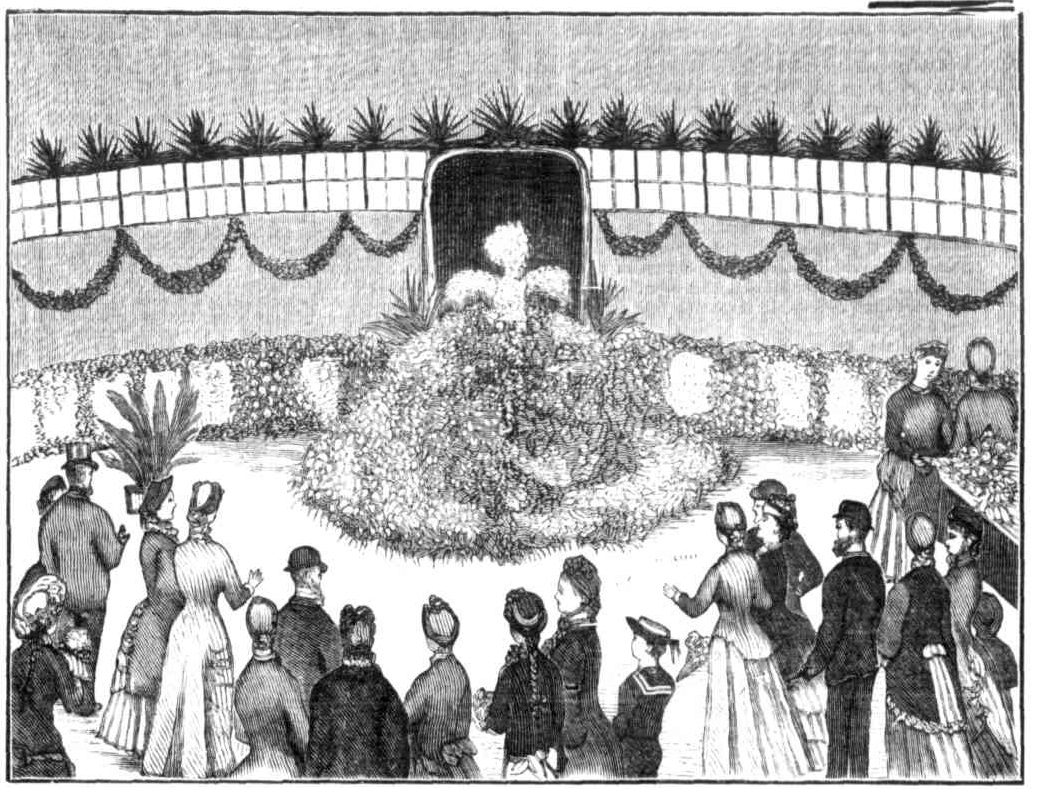
SKETCHES AT THE MANLY FLOWER SHOW.
forget-me-not, and blue flowers. A bridal wreath, some very pretty bouquets, and flower baskets, where among the other exhibits. In the next stall, Mrs. George Smith had s very beautiful anchor worked in violet and white blossoms, and at the back of the many pretty bouquets on the stall was a rockery. Meadames Robey and Tedd had a very abundant display of bouquets, many of which were worked fancifully with stars and crosses. Here also was certainly the most perfect plant of the white wild rose m the hall. A handsome basket was worked in pink roses, spider flower, and lilipilli. At the back of the stall was very elaborately worked design in leaves and flowers bearing the Irish welcome. Mesdam.es Christian and Doddemead had a very neat fanner arrangement of wild flowers and some very large floral 'fl baskets. They, too, were the envied possessors of a quantity of white clematis, difficult to get so early in the season. A fine Prince of Wales feather in flowers was also a noticeable feature of this stall. Miss Smith had a novelty in the way of a Persian carpet in native roses, with a Prince of Wales feather embossed on it in small white flowers. Miss Stubbs showed a very fine bridal bouquet, indeed so fine that it found a purchaser at a guinea. A heart worked in native roses and native may and fringed with fern leaves, a harp whose strings were beaded with golden-hued blossoms, and other pretty devices were among her exhibits. Miss M'Keown had some Very nice flowers, and next to her stall was that of the school children of Manly, presided over by Miss Bardsley. The young people had succeeded in gathering a goodly quantity of flowers, and some of them showed a little taste in their arrangement. Some beautiful clusters of waratah were conspicuous. Miss Woods' stall had many flowers, and a model of the steamer Brighton framed in leaves and blossoms was a prominent exhibit.
During the greater part of Saturday there was a constant stream of visitors going to and from the pier at Manly and Ivanhoe Park. The steamers carried between 4000 and 5000 persons to the watering-place, and it is hardly necessary to say that the pavilion which had been made attractive with its wealth of flowers and so instructive with floral designs, was thronged throughout the afternoon. Among the visitors to the show were the Premier, (the Hon. Alexander Stuart), the Hon. L. E. Cohen, the Hon. F. A. Wright, Sir John Robertson, Sir Alfred Roberts, and his Honor Mr. Justice Windeyer.
Between 5 and 6 o'clock the crowd began to thin and the stallholders commenced to illuminate their stalls for the evening exhibition, which was also largely patronised. The illumination of the main building was accomplished with patent portable gas and coloured lights, whilst a number of Chinese lanterns were suspended in the Rotunda. The scene was very charming. We understand that the Port Jackson Steamship Company have promised that they will give to the church building fund 50 per cent, of the receipts in excess of the ordinary traffic.
According to special arrangements, made at the instigation of Mr. John Woods, the native flower show was reopened on Tuesday, for the purpose of raising funds to assist the movement in aid of the widow and family of the late Captain Moreton. During the day additional steamers were put on by the Port Jackson Steamboat Company, and all necessary steps were taken to provide for the speedy transport and convenience of passengers. The flowers were fresh gathered for the occasion, and, as was fully anticipated, some hundreds of persons took the last opportunity offered of visiting the show. The show was closed at 10 o'clock at night, when the proceeds were found to be most satisfactory. The net proceeds of the day are expected to add £150 to the widow's fund. Manly has made the wild flower-show an institution of (he land. Is there anything else Manly can do ? There is indeed much, very much, if the people were fully worthy of the place. Old-world travellers have looked down from the peninsula upon that narrow sand neck between two seas, the satin robes, the harbour within, and the unwoven wool or the wild sea fleece without upon the point beyond point of the seaboard : noon the lakelets, each, as the eye of divinity, fringed with the forest skirts : and have said out of fall hearts and broad understanding, ?' There is no fairer spot in all the world;' but then, most bitter supplement, 'Nor a place with great opportunities so utterly neglected.' Has Manly aught besides wild flowers? As well ask has heaven aught betide the moon.
Manly has many delights, each as effectually buried as were the true beauties of the wild flowers a couple of years ago. Let us imagine Manly as it might be : with a perfect garden from 'sea to sea ; with a well-made drive about all that peninsula which is not surrendered to quarantine ; with those little lakes along the northern coast, approachable by railway, each made merry by half a dozen toy steamboat*, and with quaint pagodas about all their shores ; with a great sea field fenced against sharks, but free to all who would conform to simple rules to frolic or to swim ; and with another enclosure for those who loved better to roll in the foamy billows of the open sea. '. Manly with half-a-dozen wharfs, and as many Brightens and Fairlights up and down, and a railway running from the city a dozen times a day : that is the Manly which will certainly be a hundred years hence, which might be in the next decade, which should be now. Show of Wild Flowers at Manly. (1883, September 22). The Sydney Mail and New South Wales Advertiser (NSW : 1871 - 1912), p. 545. Retrieved from http://nla.gov.au/nla.news-article162027920
Deputations.
THE FAIRLIGHT ESTATE AT MANLY.
Yesterday Sir John Robertson received a deputation from Manly, consisting of Mr. J. J. Lough. (Mayor) and Aldermen Pitt, Hayes, Small, and Mr. Wagstaff, Council Clerk. The object of the deputation was to ask that the reservation of 100ft above high water-mark opposite the Fairlight Estate might be dedicated to the council for a recreation ground, and vested in the trustees of the oilier recreation reserves. Mr. Woods, the owner of the Fairlight Estate, who claims the 100ft as part of the grant to his predeceasor in circumstances of the case, and the action taken by the Municipal Council and what transpired at the recent public meeting with reference to the strip of land in question. Mr. Woods stated that he was willing to give a sufficient reserve, but not bind himself to a hard and fast line of 100ft. Sir John Robertson explained that the Governor and Executive Council had no power to put the reservation in force, but there hadj never been a case where all of a reservation had been taken back by the Government. All he could do was to follow the law. When Mr 'Woods application for the rescission of the reservation ... anyone could...objection. The deputation and anyone's ... considered, and he would then give his decision. Deputations. (1882, July 29). Evening News (Sydney, NSW : 1869 - 1931), p. 4. Retrieved from http://nla.gov.au/nla.news-article108203690
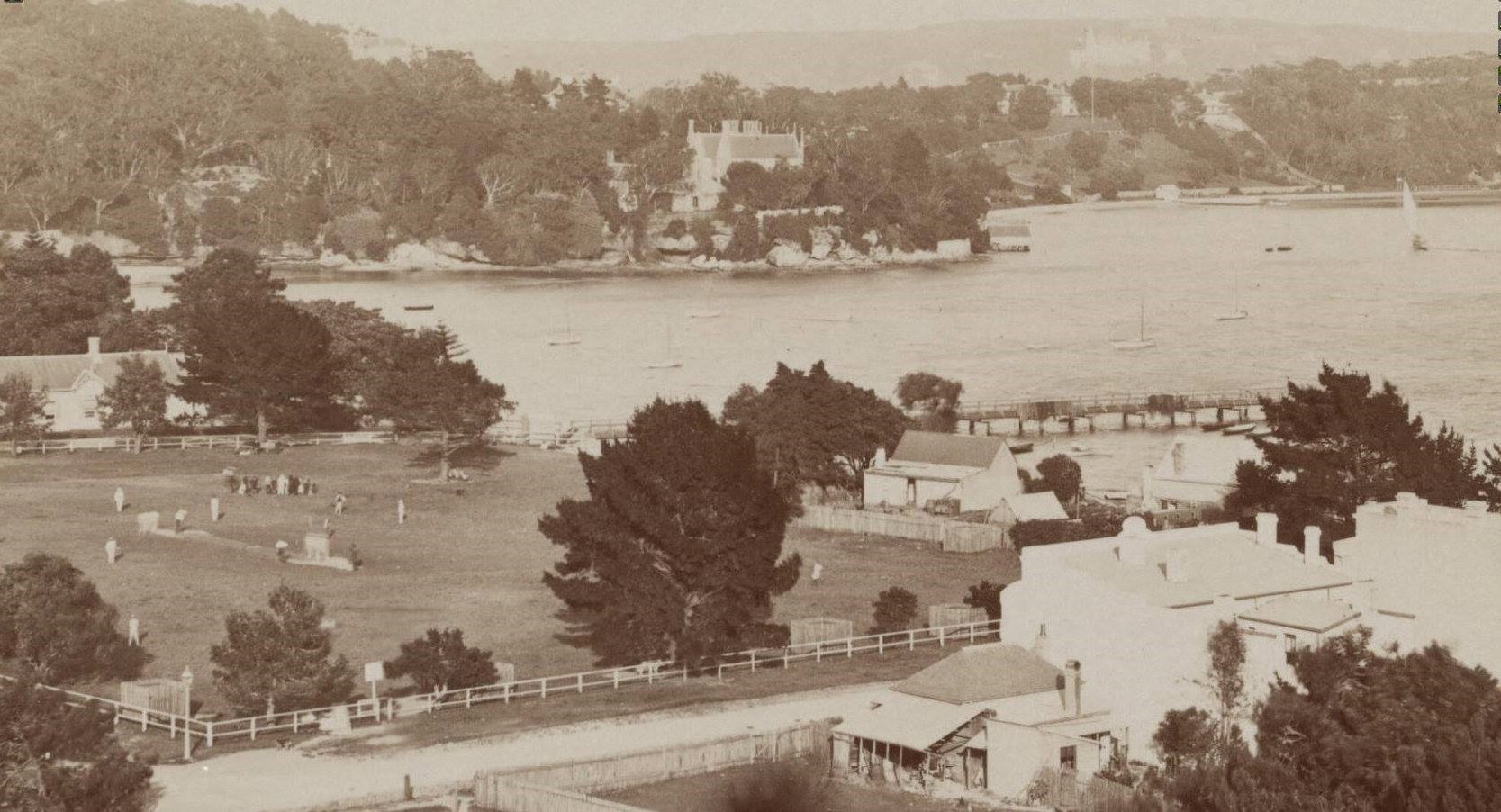
View over a cricket match towards Fairlight House and Cardinals Palace, Manly. Courtesy National Library of Australia, 1895, by Charles Bayliss, from http://nla.gov.au/nla.obj-141507260. Zoomed in to show detail. NB: Author of page has 'flipped' this plate glass photo as digitised by NLA to show correct position of Cardinal's Palace setting on hill in distance.
Advocate for transport - he was a prolific letter writer, many examples available through TROVE:
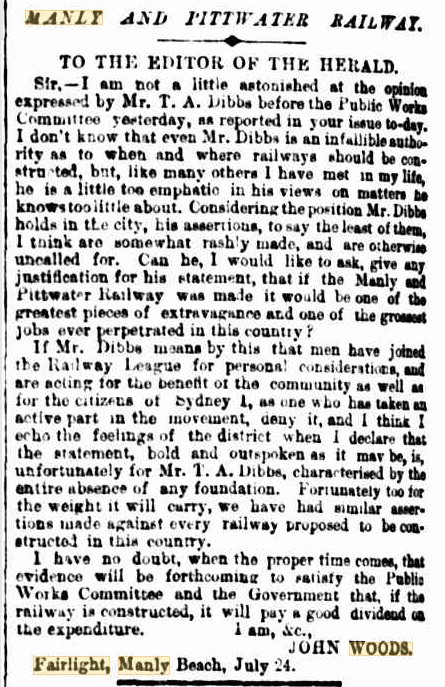
MANLY AND PITTWATER RAILWAY. (1890, July 25). The Sydney Morning Herald (NSW : 1842 - 1954), p. 6. Retrieved from http://nla.gov.au/nla.news-article13790324
ACCIDENT TO MR. JOHN WOODS.
The many friends of this gentleman will regret to learn that while at the Camperdown horse sales yesterday ho was struck by a young unbroken colt so severely that several of his ribs were fractured, and it will be some days before he will be about again. Mr. Woods is confined to bis bod at his residence, Fairlight, Manly, and is receiving every care from his family and medical attention from Dr. Watkins. ACCIDENT TO MR. JOHN WOODS. (1895, February 27). The Australian Star (Sydney, NSW : 1887 - 1909), p. 3. Retrieved from http://nla.gov.au/nla.news-article227117211
Mr. John Woods, of ' Fairlight,' Manly, celebrated the 70th anniversary of his birth on Anniversary Day. It is 50 years since Mr. Woods came to Australia, and in that time he has played many useful parts, having for some time been a City Alderman and Mayor of Sydney. He is still vigorous for his age, and takes an active interest in every movement which needs his aid. PERSONAL. (1899, February 4). Freeman's Journal (Sydney, NSW : 1850 - 1932), p. 17. Retrieved from http://nla.gov.au/nla.news-article111079751
'Many happy returns' to-day to Mr. John Woods,, of Fairlight, Manly, born January 26, 1828. PERSONAL (1902, January 26). Sunday Times (Sydney, NSW : 1895 - 1930), p. 7. Retrieved from http://nla.gov.au/nla.news-article126429514
BIFFIN At Fairlight, Manly, Mrs. Mary Ann Biffin, aged 88 years (for 35 years the faithful servant of Mr. John Woods). Family Notices (1902, November 25). The Sydney Morning Herald (NSW : 1842 - 1954), p. 1. Retrieved from http://nla.gov.au/nla.news-article14517245
Death: WOODS JOHN 9964/1904 parents: MOSES NELLIE registered at MANLY
DEATHS.
WOODS.— July 13, at his residence, Leona, Manly. John Woods, aged 76. Family Notices (1904, July 14). The Australian Star (Sydney, NSW : 1887 - 1909), p. 4 (FIRST EDITION). Retrieved from http://nla.gov.au/nla.news-article228255889
PERSONAL.
One of Sydney's oldest residents, in the person of Mr. John Woods, passed away yesterday at his residence, Leona, Manly. The deceased some time ago was seized with a paralytic fit, from which he partially re-covered, but a few weeks after convalescence he received serious injuries through being thrown from his carriage, the effects of which hastened his end. Mr. Woods was a native of Ireland, having been born at Castleblayney. In the county of Monaghan, In 1828. He arrived with his wife in Sydney in 1853, where he commenced business as a contractor and carrier. One of his first contracts was the cartage of the rails from Sydney Cove to Redfern for the railway then starting to Parramatta. He took up his residence in Manly 37 years ago, and was regarded as the pioneer of the village. In conjunction with Messrs., R. M. Pitt and C. H. Hayes and a few more of the local residents, he planted at his own expense the pine trees on the Ocean Beach Reserve, now one of the features of Manly., He filled the office of Mayor of Sydney, and until the readjustment of the electoral districts acted as returning officer for Warringah. He was also a director of many companies, including the Port Jackson Co-operative Steamship Company (acting as chairman for some years), Messrs. Pitt, Son, and Badgery, the Manly Gaslight Company, Wright, Heaton, and Co., the Victory Gold Mine, and the old Sydney Tramways and Omnibus Company. He was interested in cattle runs in Queensland, where he suffered losses by last year's drought. His family consisted of nine children. His third eldest is the well-known captain of Somersetshire County Cricket Cub, S. M. J. Woods. Another son is Harris Woods, adjutant in the Irish Rifles, returning officer for the Middle Harbour electorate, and captain of the Manly Cricket Club. Last year the deceased gentleman celebrated his golden wedding at his Manly residence. The function was attended by all his descendants., The funeral leaves his house for the Manly Cemetery at 3 o'clock to-day. PERSONAL. (1904, July 14). The Sydney Morning Herald (NSW : 1842 - 1954), p. 7. Retrieved from http://nla.gov.au/nla.news-article14648175
Death of Mr- John Woods.
Mr. John Woods, a well-known business man of this city, died At Manly last week. The deceased some time ago was seized with a paralytic fit, from which he partially recovered, but a few weeks after convalescence he received serious injuries through being thrown from his carriage, the effects of which hastened his end. Mr. Woods was a native of Ireland, having been horn at Castleblayney, in the county of Monaghan, in 1828. He arrived with his wife in Sydney in 1853, where he commenced business as a contractor and carrier. One of his first contracts was the cartage of the rails from Sydney Cove to Redfern for the railway then starting to Parramatta.
He took up his residence in Manly 37 years ago, and was regarded as the pioneer of the village. In conjunction with Messrs. R. M. Pitt and C. H. Hayes and a few more of the local residents, he planted at his own expense the pine trees on the Ocean Beach Reserve, now one of the features of Manly. He filled the office of Mayor of Sydney, and until the readjustment of the electoral districts acted as returning officer for Warringah. He was also a director of many companies, including the Port Jackson Cooperative Steamship Company ('acting as chairman for some years), Messrs. Pitt, Son, and Badgery, the Manly Gaslight Company. Wright. Heaton, and Co., the Victory Gold Mine, and the old Sydney Tramways and Omnibus Company. He was interested in cattle runs in Queensland, where he suffered losses by last year's drought. His family consisted of nine children. His third eldest is the well-known captain of Somersetshire County Cricket Club, S. M. J. Woods. Another son is Harris Woods, adjutant in the Irish Rifles, returning officer for the Middle Harbour electorate, and captain of the Manly Cricket Club. Last year the deceased gentleman celebrated his golden wedding at his Manly residence. The function was attended by all his descendants.
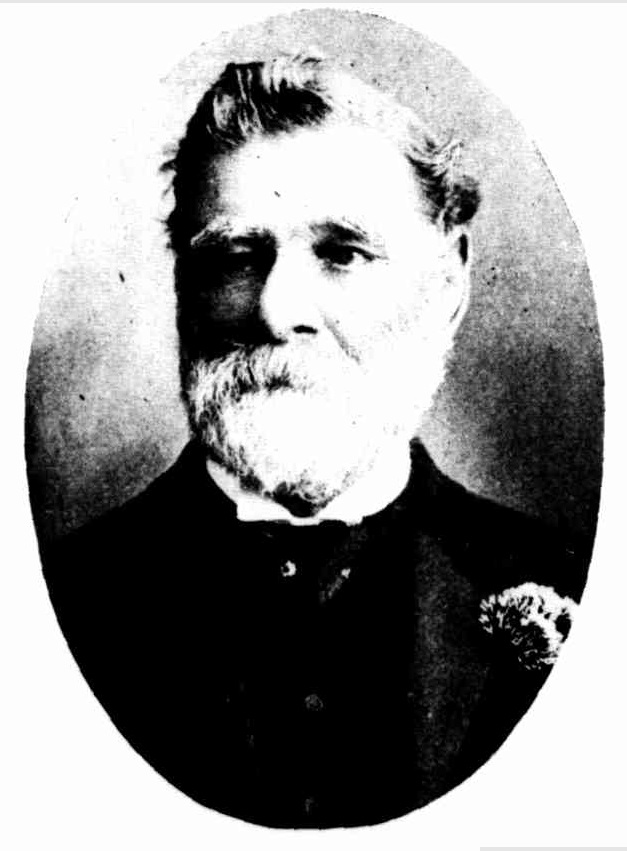
Photo, by Talma, 374 George-street. LATE JOHN WOODS.
Death of Mr. John Woods. (1904, July 20). The Sydney Mail and New South Wales Advertiser (NSW : 1871 - 1912), p. 161. Retrieved from http://nla.gov.au/nla.news-article164909524
THE LATE MR. JOHN WOODS.
The funeral of the late Mr. John Woods took place at Manly yesterday afternoon. There was a large attendance, the cortege being over half a mile long. The coffin was covered with wreaths of white flowers, and the private cartilage of the deceased gentleman followed the hoarse, also loaded with beautiful floral designs. The interment took place in the Church of England portion of the cemetery, the Rev. J. F. Blair reading the service, after which the Rev. J. Anderson Gardiner delivered an address on the life-work of the. deceased. Messrs. Harris I and Cameron Woods, sons, and Mr. J. A. Dean, son-in-law, acted as chief mourners. Amongst those present were the Mayor, aldermen, and council-clerk of Manly, Messrs. M. W. Webb, C.M.G., J. J. Calvert. Geo. Miller, W. H. Sraellic, C. H. Hayes, W. H. Fletcher, H. S. Bailgery, J. P. Wright, John Young, J. Falorson, Alex. Dean, \V: M. Felion, S. E. Sadler, G. S. Littlojohn, J. M. Paxton, W. J. Gillies, F. Browne, Colonel Strong, Captain Downie, Captain Hart, Dr. Thomas, Dr. Harvey, Messrs. J. H. Burns, W. II. German, J. D. German, It. Luckhnm, E. Ridge, II. Hudson. T. Weilderburu, F. Hunt, W. ICil-minster, J. E. Butler, A. Learmonth, I. Pope, J. Bonner, A. Forsyth, J. J. Lough. H. E. Steven-sou, F. P. Tompson. J. Hanson, J, Eccles, Major J. Ramlal Carey, Messrs. J. Simpson, G, L. Rieliardson, G. U. Hosking. W. Rosenthal. J. Roche, and Jas, Marks.
Floral tributes were sent by the Woods family, Mr. and Mrs. C. G. Woods, Mr. E. Resell, the employees of the Riverstone Meat Company, Messrs. C. R. Austin. H. T. Robey, T. Richards, Wright, Heaton, and Co., Port Jackson Co-operative Steamship Company, Manly Municipal Council, employees of the Port Jackson Co-operative Steamship Company, the Mayor of Manly, Mr. E. W. Quirk, M.L.A., Messrs. John Pope. N. Pope, Dr L I Watson Harvey, W. H. Slicnstonc, Manly Cricket Club, tho directors ot the Manly Gaslight Company, Mr. C, A. Laurence, the Manly Football ' Club, Pitt, Son, and Badgery, Messrs. W. G Parish, J. Simpson, Mrs. Kilminster, Mrs. Dunmore Lang, Mrs. Kirk, Mr. Jas. Marks, Miss Marks, and many others.
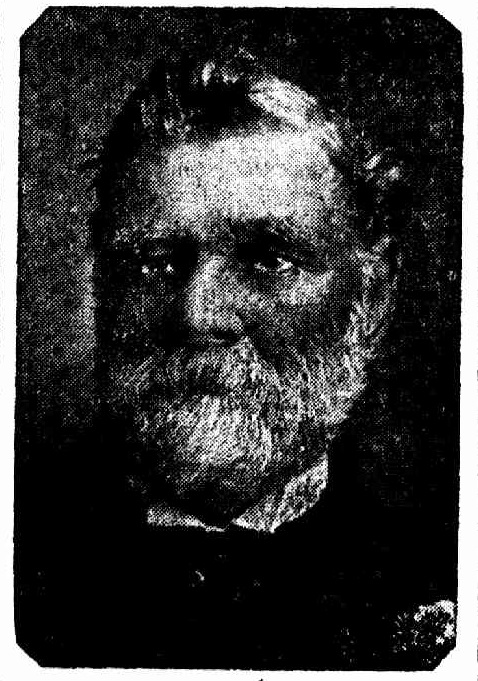
(Photo- Talma.)
THE LATE MR. JOHN WOODS. (1904, July 15). The Daily Telegraph (Sydney, NSW : 1883 - 1930), p. 5. Retrieved from http://nla.gov.au/nla.news-article236890573
DEATH OF AN OLD SYDNEY IDENTITY.
On Monday last there died at Chapel street Kogarah, an old Sydney identity, in the person of Mrs. Margaret Woods, relict of John Woods, of Fairlight, Manly, aged 80 years. John Woods was a well known citizen of many years standing, and. a useful one at that. He. was a contractor from the mid-fifties in the carrying line and one of the founders of the old firm of Woods, Shortland and Company, and of the Omnibus Company, which flourished prior to the invasion of the steam motor. Betty McMahon was in these combinations, and held on to the good things. Mr. Woods also took a prominent 'part in civic life, and was Mayor in 1885. He died at Fairlight: about ten years ago, A son became noted in England aa a cricketer, and is the husband of Maud Fitz Stubbs, the well known musician. DEATH OF AN OLD SYDNEY IDENTITY. (1913, July 13). Truth (Sydney, NSW : 1894 - 1954), p. 9. Retrieved from http://nla.gov.au/nla.news-article168746406
A BIG ESTATE.
The Late Mr. John Woods. BEQUESTS UNDER HIS WILL
The will of the late Mr. John Woods, of Manly, has been lodged for probate. The value of the estate Is set down at £20,832. The testator appoints his sons, John and Harris Dunmore Lang woods, his sons-in-law, John Adam Dean, builder, of Castlereagh-street, and Frederick William Browne, of Messrs. Wright, Beaton and Co., Limited, trustees and executors of the estate. The deceased bequeaths his household furniture, pictures, plate. &c., to his wife during her widowhood, and the whole of his real and personal estate Is devised to the trustees upon Trust. (The trustees are empowered to register In the name of Harris Dunmore Lang Woods a sufficient number of shares In Wright, Heaton and Co., Ltd., to qualify him as a Director of the firm. Out of the income of the residuary estate an annuity of £26 is bequeathed to Valentine Woods, and another Of £400 or more, as the trustees think fit, to Mrs. Woods, during her widowhood. The remainder of the Income Is to accumulate during Mrs. Woods' widowhood, or until 20 years after the testator's death, whichever may be the shorter period, when It Is to be paid to the residuary estate on the death or the marriage of the widow. A BIG ESTATE. (1904, September 12). The Australian Star (Sydney, NSW : 1887 - 1909), p. 5 (FIRST EDITION). Retrieved from http://nla.gov.au/nla.news-article228261153
£400 pounds in 1904 translates to around $52,860.00 in 2018 - relative income value of that income or wealth is $433,000.00 relative output value of that income or wealth is $2,740,000.00. Average pension paid in 2019 is approximately $24,081 per year - Single: $926.20 per fortnight - so more than enough for tea and toast!
STORIES TOLD OF SAMMY WOODS.
S. M. J. Woods, one of the Woods, boys of Manly, was sent by his father, the late Mr. John Woods, to school in England in company with his brother, the late Mr. Harris D. L. Woods. Sammy went to Cambridge University and made a tremendous reputation as a cricketer and Rugby Union footballer. As a youngster he was invited to play for Australia against England in a Test match at Home. And he represented England in many Rugger Internationals, it being generally admitted that he was one of the greatest forwards of all time. Here follow some G. L. Jessop stories of the inimitable Sammy, who, by the way is an uncle of Mr. Val Woods, of the Waverley District Cricket Club. ''It was the first time I had the pleasure of playing under the leadership of Sam Woods, and a more inspiring leader I could not wish for. Sam was a great personality in the cricket world long before I emerged from the obscurity of club cricket. And to me he was almost as much a hero as the old man himself. …. TIT BITS in SPORT (1922, September 15). Arrow (Sydney, NSW : 1916 - 1933), p. 12. Retrieved from http://nla.gov.au/nla.news-article103446006